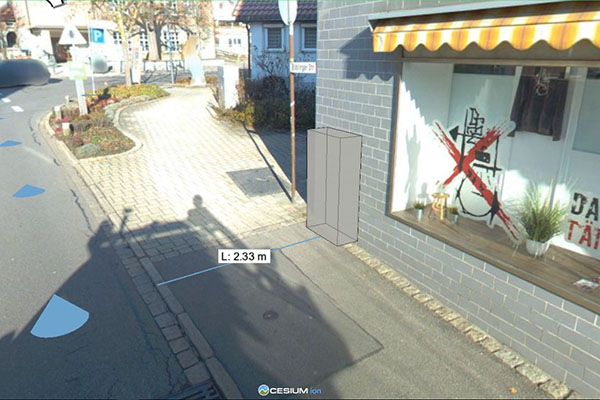Fiber-optic network expansion for the future
Deutsche Telekom in Germany is relying on digital tools for planning the new cable routes and distribution boxes for its fiber-optic network expansion. Fraunhofer IGD has developed software that further automates the planning process and makes it possible for Telekom workers to submit proposals to local governments without time-consuming site inspections. This saves time and, in the future, will ensure that work becomes even more digital and approval processes faster, allowing the expansion to proceed unhindered. Fraunhofer IGD’s Fibre3D software has just passed its first practical test.

(Darmstadt) To supply Germany with fast Internet, Deutsche Telekom is significantly advancing the expansion of its fiber-optic network nationwide. The actual placement of the thin fiber-optic cables is one of the last steps in this complex expansion process. Before that can happen, extensive planning work is required along with applications to government offices and municipalities, with numerous rounds of approvals and on-site appointments. To speed up these processes, Deutsche Telekom is banking on automated methods: Special cameras and laser scanners producing digital map data, and automatic object detection proposing distribution box locations and cable routes that then only need to be confirmed by planners.
Distribution boxes: virtual planning in 3D
However, a small but decisive detail was one that, before, could not be planned out from a desk, rather it always required on-site inspections and sizing: The placement of the distribution boxes that run the individual fiber-optic cables from the main line to households. With prior 2D map data, it was impossible to determine the ideal location and account for every factor, such as the mandatory width of the remaining sidewalk. Time-consuming inspections of the actual sites by planners was the only way to find a suitable location. The Fibre3D software from the Fraunhofer Institute for Computer Graphics Research IGD will soon make it possible for planners to dive into a 3D world and position the boxes virtually, allowing them to find the best location from their desks. Measuring functions and true-to-scale projections also make speedy surveys possible even at technically challenging locations. Once digital planning is complete, concrete composite images can be generated directly from the tool to be included in the application documents for securing the location. This realistic impression also facilitates the approval process for the party liable for maintenance.
Elaborate planning phase shortened considerably
An initial version of Fibre3D was used by Deutsche Telekom in four planning units. “In one case, a colleague was able to prepare 27 locations in a single day and send them directly to the local government for approval¾all digitally,” described Marius Kraus, Fibre3D product owner at Deutsche Telekom Technik GmbH, in his initial feedback. With on-site appointments, photographs, and application after the fact, that would not have been possible. “With the classical process, our staff spent a lot of time on the street. Reworking locations when a local government has a change request also goes much faster. ” The developers at Fraunhofer IGD are currently working on visualizing the underground routes and making changes based on the feedback from the initial practical tests.
 Fraunhofer Institute for Computer Graphics Research IGD
Fraunhofer Institute for Computer Graphics Research IGD